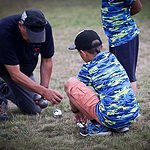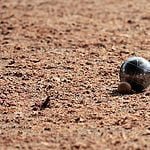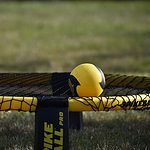Have you ever wondered what exactly constitutes a volley in pickleball?
Well, it's more than just a simple swing of the paddle. Understanding the nuances of a pickleball volley can significantly impact your game.
From the basics of when to execute a volley to the intricate techniques involved, a deep dive into this essential skill can elevate your gameplay to new heights.
So, let's explore the world of volleys in pickleball and unlock the secrets to mastering this crucial aspect of the game.
Key Takeaways
- Pickleball volleys are shots struck in the air near the net.
- Mastering volley techniques enhances game control and pace.
- Quick reflexes and precise timing are crucial for successful volleys.
- Volleys disrupt opponents' rhythm and create scoring opportunities.
Definition of a Pickleball Volley
Mastering the art of executing a pickleball volley is essential for maintaining control and applying pressure during intense rallies on the court. In pickleball, a volley is a shot where the ball is struck in the air before it bounces on the court. This technique is crucial for dictating the pace of the game and keeping your opponents on their toes. Typically, volleys are performed near the non-volley zone (NVZ), allowing players to be in a strategic position to respond to various shots.
The trajectory of a pickleball volley is usually kept low to medium, aimed at specific placements on the court to keep your opponents off balance. Different types of volleys, such as the soft touch volley or the aggressive put-away volley, can be employed based on the situation to outmaneuver your opponents. Mastering the technique of executing these various types of volleys can significantly impact your gameplay, enhancing your overall performance on the court. By honing your volley skills, you can become a formidable force in the game of pickleball.
Characteristics of a Volley Shot
The key characteristics of a pickleball volley shot include its requirement to be executed within the non-volley zone (NVZ) and the necessity for quick hand-eye coordination and precise timing.
Unlike groundstrokes where the ball bounces before hitting it, the volley shot is made in the air, demanding players to be positioned close to the net. This proximity increases the pressure on players as they must react swiftly to incoming shots.
Control is paramount in volleys as the quick exchange of shots often determines the outcome of the point. By mastering volleys, players can keep their opponents on their toes, forcing them to react rapidly to the fast-paced nature of the game.
Successful volleys not only lead to quick point wins but also provide players with strategic advantages by allowing them to dominate the net and dictate play. Practice and honing your volley skills can significantly enhance your overall performance on the pickleball court.
Key Differences From Other Shots
When comparing the volley shot in pickleball to other types of shots, the key distinction lies in its execution without allowing the ball to bounce on the court. Here are three key differences that set volleys apart from other pickleball shots:
- Quick Reflexes: Volleys demand rapid reaction times as players must hit the ball in the air before it touches the ground, requiring sharp reflexes to anticipate and execute the shot effectively.
- Controlled Movements: Unlike groundstrokes where players have more time to prepare, volleys necessitate controlled movements to accurately direct the ball due to the limited time available for adjustments.
- Short Swing, Precise Timing: Volleys are typically executed with a short swing to maintain control and placement, emphasizing the importance of precise timing to make solid contact with the ball.
Mastering volleys in pickleball involves honing these skills to ensure success at the non-volley zone line, also known as the kitchen.
Importance of Mastering Volleys
Enhancing your volley skills in pickleball elevates your control, precision, and ability to dictate the game's pace. A strong volley game is crucial for maintaining dominance at the net, whether you're on offense or defense. By mastering volleys, you apply constant pressure on your opponents, forcing errors and creating opportunities for quick transitions from defense to offense.
This skill not only leads to quicker point finishes but also enhances your defensive capabilities against low shots, making you a formidable presence at the net. Effective volleys allow you to control the game's flow, keeping your opponents on their toes and creating discomfort for them.
Regular practice and honing of your volley technique are essential for elevating your overall gameplay performance and strategic decision-making on the pickleball court. Remember, the net is your domain, and mastering volleys is key to asserting your authority and seizing control of the game.
Proper Technique for Volleys
To excel in pickleball volleys, focus on mastering the proper technique for optimal performance on the court. Here are three key elements to consider:
- Paddle Position: Keep your paddle face square when hitting volleys to ensure better control and accuracy. Avoid excessive backswing, and focus on using controlled blocking motions to return the ball effectively.
- Footwork: Emphasize proper footwork to position yourself correctly for volleys. Good footwork helps in adjusting quickly to the ball's trajectory and improves your reaction time during fast-paced exchanges at the net.
- Angles and Adjusting: Practice hitting volleys at various angles and speeds to enhance your consistency and precision. Learn to adjust the paddle face based on the type of volley you're executing to control the ball's placement effectively.
Mastering these techniques will elevate your volley game and give you an edge on the pickleball court.
Common Mistakes to Avoid
To avoid common mistakes that can hinder your volley performance in pickleball, focus on key aspects such as maintaining control, avoiding excessive force, and positioning yourself effectively on the court. Here are some common errors to steer clear of when working on your volleys:
| Common Mistakes | How to Avoid |
|---|---|
| Allowing the ball to drop too low | Keep your paddle up and in front of you to take the ball at the highest point possible. This helps maintain control and prevents errors. |
| Using excessive force | Focus on a short, controlled motion rather than a full swing. This will help you keep the ball in play and avoid hitting shots out of bounds. |
| Poor footwork and positioning | Work on your footwork to move efficiently on the court and position yourself correctly for effective volleys. Adjust your paddle angle accordingly for the type of volley you need to execute. |
Strategies for Effective Volleys
Positioning yourself close to the net and anticipating your opponents' shots are crucial elements in executing effective volleys in pickleball. To enhance your volley game, consider the following strategies:
- Utilize Quick Footwork and Coordination: Move swiftly on the court to cover your side effectively and work in sync with your partner to avoid leaving any gaps open for your opponents to exploit.
- Adjust Based on Opponents' Weaknesses: Identify your opponents' weaknesses and tailor your volleys accordingly. Targeting their backhand side can often yield favorable results, and varying your shots can help you stay on the offensive.
- Focus on Precision and Communication: Maintain a ready position, use concise and controlled swings to ensure precision in your volleys. Additionally, establish clear communication with your partner through hand signals and verbal cues to coordinate movements and support each other during intense rallies.
When to Execute Volleys
When considering the timing of executing volleys in pickleball, a key aspect to keep in mind is the dynamic nature of the game and the strategic advantages that well-timed volleys can provide.
To hit volleys effectively, keep your eyes on the ball and ensure your paddle is in the right position to make contact. The ball must be struck before it bounces on your side of the court, allowing you to maintain control and pressure near the non-volley zone.
By hitting volleys when your opponents hit hard and low shots, you can keep your opponents on their toes and force them to react quickly. Mastering the art of hitting volleys won't only make you a more formidable opponent but also allow you to volley like a pro, dictating play and increasing your chances of winning points.
Impact of Volleys on Game Dynamics
Influencing the flow and intensity of a pickleball match, volleys play a pivotal role in shaping the game dynamics through quick net exchanges and strategic maneuvering. When you execute volleys at your opponents, you aren't only aiming to win the point but also aiming to disrupt your opponents' rhythm, creating uncertainty and forcing errors that can lead to scoring opportunities.
Strategic gameplay involving volleys requires agility, quick reflexes, and precise decision-making skills to outmaneuver your opponents and gain a competitive advantage on the court. By mastering the art of volleying, players can control the pace of the game, dictate the direction of play, and set themselves up for success in crucial points.
Training Drills to Improve Volleys
To enhance your volleying skills in pickleball, implementing targeted training drills is essential for achieving precision and consistency on the court. Incorporate wall drills to enhance hand-eye coordination and consistency in your volleys. Practice partner drills to develop quick reflexes and improve your volleying accuracy. Utilize ball machine sessions to simulate various volley scenarios, enhancing your overall skill set. Integrate volleys into your warm-up routines to refine technique and prepare effectively for matches. Seeking coaching or attending clinics can provide personalized feedback and guidance to help you improve your volley skills significantly.
| Training Drills | Description | Benefits |
|---|---|---|
| Wall Drills | Improve hand-eye coordination and consistency in volleys. | Enhances precision in volleys. |
| Partner Drills | Develop quick reflexes and improve volleying accuracy. | Enhances reflexes and accuracy. |
| Ball Machine Sessions | Simulate various volley scenarios for skill enhancement. | Provides a diverse training setting. |
| Warm-up Routines | Refine technique and prepare effectively for matches. | Helps in match readiness. |
| Coaching/Clinics | Obtain personalized feedback and guidance on improving volley skills. | Offers tailored improvement plans. |





